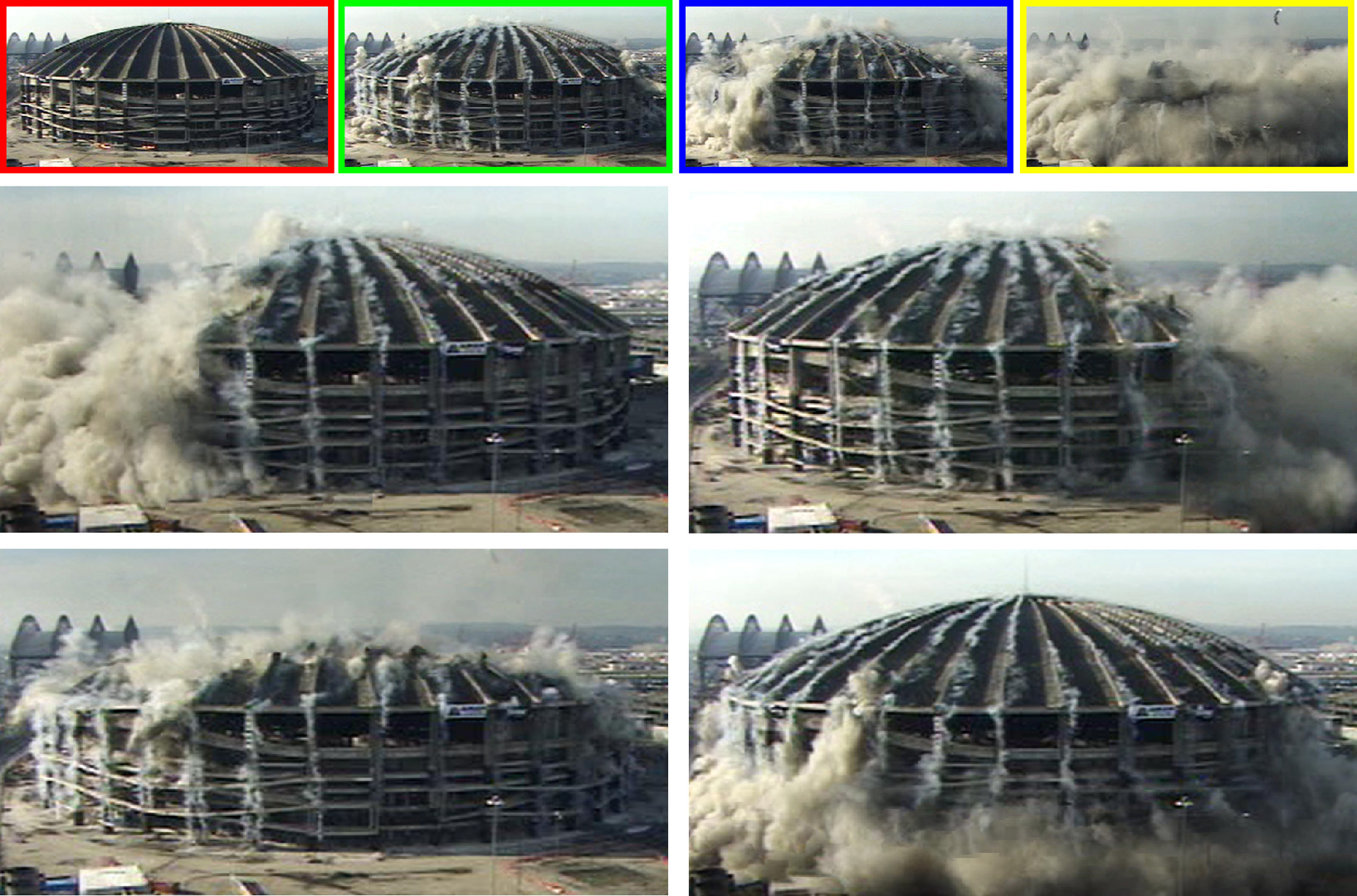“Interactive digital photomontage” by Agarwala, Dontcheva, Agrawala, Drucker, Colburn, et al. …
Conference:
Type(s):
Title:
- Interactive digital photomontage
Presenter(s)/Author(s):
Abstract:
We describe an interactive, computer-assisted framework for combining parts of a set of photographs into a single composite picture, a process we call “digital photomontage.” Our framework makes use of two techniques primarily: graph-cut optimization, to choose good seams within the constituent images so that they can be combined as seamlessly as possible; and gradient-domain fusion, a process based on Poisson equations, to further reduce any remaining visible artifacts in the composite. Also central to the framework is a suite of interactive tools that allow the user to specify a variety of high-level image objectives, either globally across the image, or locally through a painting-style interface. Image objectives are applied independently at each pixel location and generally involve a function of the pixel values (such as “maximum contrast”) drawn from that same location in the set of source images. Typically, a user applies a series of image objectives iteratively in order to create a finished composite. The power of this framework lies in its generality; we show how it can be used for a wide variety of applications, including “selective composites” (for instance, group photos in which everyone looks their best), relighting, extended depth of field, panoramic stitching, clean-plate production, stroboscopic visualization of movement, and time-lapse mosaics.
References:
1. AKERS, D., LOSASSO, F., KLINGNER, J., AGRAWALA, M., RICK, J., AND HANRAHAN, P. 2003. Conveying shape and features with image-based relighting. In IEEE Visualization, 349–354. Google ScholarDigital Library
2. BOYKOV, Y., VEKSLER, O., AND ZABIH, R. 2001. Fast approximate energy minimization via graph cuts. IEEE Transactions on Pattern Analysis and Machine Intelligence 23, 11, 1222–1239. Google ScholarDigital Library
3. BRAUN, M. 1992. Picturing Time: The Work of Etienne-Jules Marey. The University of Chicago Press.Google Scholar
4. BURT, P., AND KOLCZYNSKI, R. 1993. Enhanced image capture through fusion. In International Conference on Computer Vision (ICCV 93), 173–182.Google ScholarCross Ref
5. DANIELSSON, P.-E. 1980. Euclidean distance mapping. Computer Graphics and Image Processing 14, 227–248.Google ScholarCross Ref
6. DAVIS, J. 1998. Mosaics of scenes with moving objects. In Computer Vision and pattern Recognition (CVPR 98), 354–360. Google ScholarDigital Library
7. FATTAL, R., LISCHINSKI, D., AND WERMAN, M. 2002. Gradient domain high dynamic range compression. ACM Transactions on Graphics 21, 3, 249–256. Google ScholarDigital Library
8. FREEMAN, W. T., AND ZHANG, H. 2003. Shape-time photography. In Conference on Computer Vision and Pattern Recognition (CVPR 03), 151–157.Google ScholarCross Ref
9. HAEBERLI, P. 1994. Grafica Obscura web site. http://www.sgi.com/grafica/.Google Scholar
10. KWATRA, V., SCHÖDL, A., ESSA, I., TURK, G., AND BOBICK, A. 2003. Graph-cut textures: Image and video synthesis using graph cuts. ACM Transactions on Graphics 22, 3, 277–286. Google ScholarDigital Library
11. LEVIN, A., ZOMET, A., PELEG, S., AND WEISS, Y. 2004. Seamless image stitching in the gradient domain. In European Conference on Computer Vision (ECCV 04), (to appear).Google ScholarCross Ref
12. LUCAS, B. D., AND KANADE, T. 1981. An iterative image registration technique with an application to stereo vision. In Proceedings of the 7th International Joint Conference on Artificial Intelligence (IJCAI ’81), 674–679.Google Scholar
13. MASSEY, M., AND BENDER, W. 1996. Salient stills: Process and practice. IBM Systems Journal 35, 3&4, 557–574. Google ScholarDigital Library
14. MEYER, C. 2000. Matrix Analysis and Applied Linear Algebra. Society for Industrial and Applied Mathematics. Google ScholarDigital Library
15. MORTENSEN, E. N., AND BARRETT, W. A. 1995. Intelligent scissors for image composition. In Proceedings of SIGGRAPH 95, Computer Graphics Proceedings, Annual Conference Series, 191–198. Google ScholarDigital Library
16. MUTTER, S., AND KRAUSE, M. 1992. Surrational Images: Photomontages. University of Illinois Press.Google Scholar
17. MUYBRIDGE, E. 1955. The human figure in motion. Dover Publications, Inc.Google Scholar
18. OGDEN, J. M., ADELSON, E. H., BERGEN, J., AND BURT, P. 1985. pyramid-based computer graphics. RCA Engineer 30, 5, 4–15.Google Scholar
19. PÉREZ, P., GANGNET, M., AND BLAKE, A. 2003. Poisson image editing. ACM Transactions on Graphics 22, 3, 313–318. Google ScholarDigital Library
20. RASKAR, R., ILIE, A., AND YU, J. 2004. Image fusion for context enhancement and video surrealism. In NPAR 2004: Third International Symposium on Non-Photorealistic Rendering, (to appear). Google ScholarDigital Library
21. REINHARD, E., STARK, M., SHIRLEY, P., AND FERWERDA, J. 2002. Photographic tone reproduction for digital images. ACM Transactions on Graphics 21, 3, 267–276. Google ScholarDigital Library
22. REJLANDER, O., 1857. Two ways of life. Photograph.Google Scholar
23. ROBINSON, H. P. 1869. Pictorial Effect in Photography: Being Hints on Composition and Chiaroscuro for Photographers. Piper & Carter.Google Scholar
24. SYNCROSCOPY, 2003. Auto-montage.Google Scholar
25. SZELISKI, R., AND SHUM, H.-Y. 1997. Creating full view panoramic mosaics and environment maps. In Proceedings of SIGGRAPH 97, Computer Graphics Proceedings, Annual Conference Series, 251–258. Google ScholarDigital Library
26. UELSMANN, J., AND COLEMAN, A. D. 1992. Jerry Uelsmann: Photo Synthesis. University Press of Florida.Google Scholar
27. UYTTENDAELE, M., EDEN, A., AND SZELISKI, R. 2001. Eliminating ghosting and exposure artifacts in image mosaics. In Conference on Computer Vision and Pattern Recognition (CVPR 01), 509–516.Google ScholarCross Ref
28. WEISS, Y. 2001. Deriving intrinsic images from image sequences. In International Conference On Computer Vision (ICCV 01), 68–75.Google ScholarCross Ref




